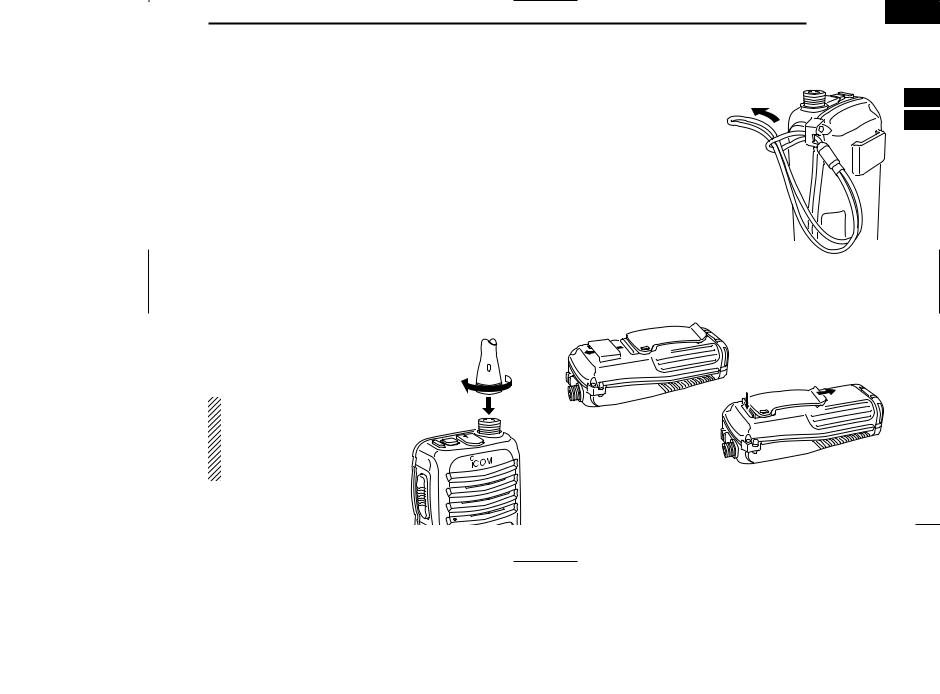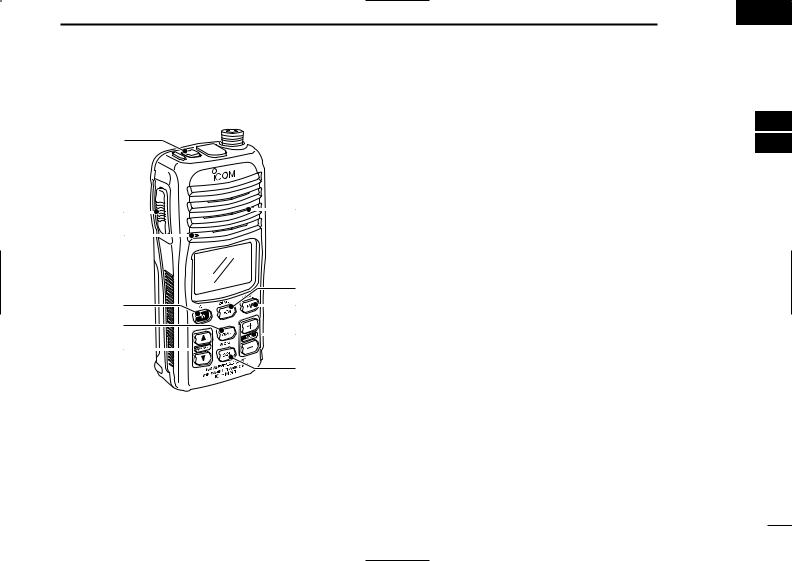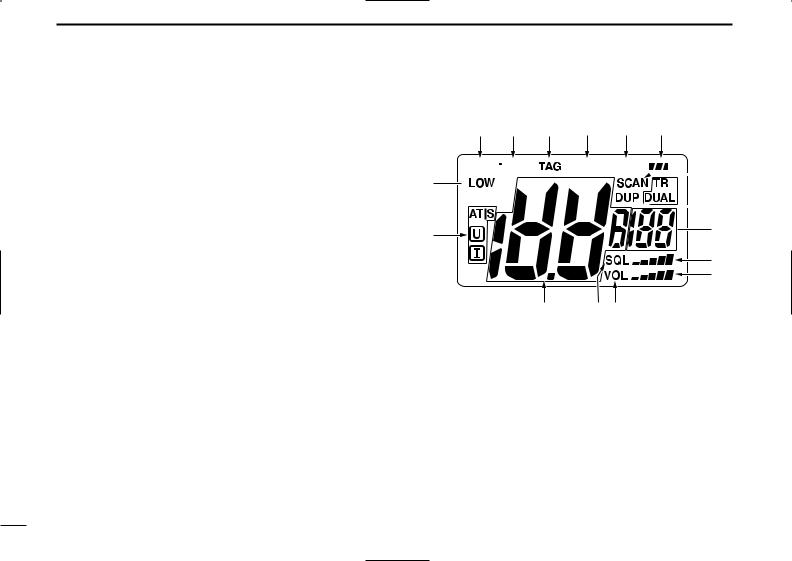Icom IC-M31 User Manual

INSTRUCTION MANUAL
VHF MARINE TRANSCEIVER
iM31

IN CASE OF EMERGENCY
If your vessel requires assistance, contact other vessels and the Coast Guard by sending a distress call on Channel 16.
USING CHANNEL 16
DISTRESS CALL PROCEDURE
1. |
“MAYDAY MAYDAY MAYDAY.” |
|
2. |
“THIS IS |
...........................” (name of vessel) |
3.Your call sign or other indication of the vessel.
4. “LOCATED AT |
.....................” (your position) |
5.The nature of the distress and assistance required.
6.Any other information which might facilitate the rescue.
RECOMMENDATION
CLEAN THE TRANSCEIVER THOROUGHLY WITH FRESH WATER after exposure to saltwater, and dry it before operation. Otherwise, the transceiver’s keys, switches and controllers may become inoperable due to salt crystallization.
i

FOREWORD
Thank you for purchasing this Icom product. The IC-M31 VHF MARINE TRANSCEIVER is designed and built with Icom’s state of the art technology and craftsmanship. With proper care this product should provide you with years of trouble-free operation.
IMPORTANT
READ ALL INSTRUCTIONS carefully and com-
pletely before using the transceiver.
SAVE THIS INSTRUCTION MANUAL—This in-
struction manual contains important operating instructions for the IC-M31.
EXPLICIT DEFINITIONS
WORD |
DEFINITION |
Personal injury, fire hazard or electric shock RWARNING may occur.
CAUTION Equipment damage may occur.
NOTE
If disregarded, inconvenience only. No risk of personal injury, fire or electric shock.
FEATURES
Waterproof construction
Built tough to withstand the punishing marine environment, the IC-M31 meets JIS waterproof specification grade 7 while using BP-223 (option) or BP-224.
Dualwatch and tri-watch functions
Convenient functions which allow you to monitor the distress channel (Ch 16) while receiving a channel of your choice—dual watch; or monitor the distress channel and another channel while receiving a channel of your choice—tri-watch.
Large, easy-to-read LCD
With dimensions of 16(H) × 32(W) mm, the IC-M31’s function display is easy to read and shows operating conditions at a glance. Backlighting and contrast can be adjusted to suit your preferences.
Simple operation
9 large buttons on the front panel provide user-friendly operation. The independent volume and channel buttons are located on the front panel for convenient one-hand operation.
ii

PRECAUTION
RWARNING! NEVER connect the transceiver to an AC outlet. This may pose a fire hazard or result in an electric shock.
RWARNING! NEVER hold the transceiver so that the antenna is very close to, or touching exposed parts of the body, especially the face or eyes, while transmitting. The transceiver will perform best if the microphone is 5 to 10 cm away from the lips and the transceiver is vertical.
NEVER connect the transceiver to a power source other than the BP-223 or BP-224. Such a connection will ruin the transceiver.
AVOID using or placing the transceiver in direct sunlight or in areas with temperatures below –15°C or above +55°C.
KEEP the transceiver out of the reach of children.
KEEP the transceiver at least 0.9 meters away from your vessel’s magnetic navigation compass.
BE CAREFUL! The transceiver’s right-side panel will become hot when operating continuously for long periods.
BE CAREFUL! The IC-M31 employs waterproof construction, which corresponds to JIS waterproof specification, Grade 7 (1 m depth for 30 min.). However, once the transceiver has been dropped, waterproofing cannot be guaranteed due to the fact that the transceiver may be cracked, or the waterproof seal damaged, etc.
MAKE SURE the flexible antenna, top panel and battery pack are securely attached to the transceiver, and that the antenna, top panel and battery pack are dry before attachment. Exposing the inside of the transceiver to water will result in serious damage to the transceiver.
Icom, Icom Inc. and the 
 logo are registered trademarks of Icom Incorporated (Japan) in the United States, the United Kingdom, Germany, France, Spain, Russia and/or other countries.
logo are registered trademarks of Icom Incorporated (Japan) in the United States, the United Kingdom, Germany, France, Spain, Russia and/or other countries.
iii

TABLE OF CONTENTS
IN CASE OF EMERGENCY ................................................ |
i |
RECOMMENDATION ........................................................... |
i |
FOREWORD ....................................................................... |
ii |
IMPORTANT ........................................................................ |
ii |
EXPLICIT DEFINITIONS ..................................................... |
ii |
FEATURES .......................................................................... |
ii |
PRECAUTION .................................................................... |
iii |
TABLE OF CONTENTS ...................................................... |
iv |
1 OPERATING RULES ...................................................... |
1 |
2 SUPPLIED ACCESSORIES AND ATTACHMENTS.... |
2–3 |
■ Supplied accessories ................................................... |
2 |
■ Attachments ................................................................. |
2 |
3 PANEL DESCRIPTION ............................................... |
4–6 |
■ Front, top and side panels............................................ |
4 |
■ Function display .......................................................... |
5 |
4 BASIC OPERATION ................................................. |
7–12 |
■ Channel selection ........................................................ |
7 |
■ Adjusting the volume level ........................................... |
9 |
■ Adjusting the squelch level .......................................... |
9 |
■ Receiving and transmitting ........................................ |
10 |
■ Call channel programming ......................................... |
11 |
■ Lock function ............................................................. |
12 |
■ Automatic backlighting .............................................. |
12 |
■ Monitor function ......................................................... |
12 |
5 |
SCAN OPERATION ................................................ |
13–14 |
|
■ Scan types ................................................................. |
13 |
|
■ Setting tag channels .................................................. |
14 |
|
■ Starting a scan .......................................................... |
14 |
6 |
DUALWATCH/TRI-WATCH .......................................... |
15 |
|
■ Description ................................................................ |
15 |
|
■ Operation ................................................................... |
15 |
7 |
SET MODE ............................................................. |
16–20 |
|
■ SET mode programming ........................................... |
16 |
|
■ SET mode items ........................................................ |
17 |
8 |
BATTERY CHARGING ........................................... |
21–24 |
|
■ Battery charging ........................................................ |
21 |
|
■ Battery cautions ......................................................... |
21 |
|
■ Optional battery case ................................................ |
22 |
|
■ Optional battery chargers .......................................... |
23 |
9 |
OPTIONAL SWIVEL BELT CLIP ........................... |
25–26 |
|
■ MB-87 contents ......................................................... |
25 |
|
■ To attach .................................................................... |
25 |
|
■ To detach ................................................................... |
26 |
10 TROUBLESHOOTING ................................................ |
27 |
|
11 CHANNEL LIST ........................................................... |
28 |
|
12 SPECIFICATIONS AND OPTIONS .............................. |
29 |
|
13 DOC.............................................................................. |
30 |
|
iv

 1 OPERATING RULES
1 OPERATING RULES
D Priorities
•Read all rules and regulations pertaining to priorities and keep an up-to-date copy handy. Safety and distress calls take priority over all others.
•You must monitor Channel 16 when you are not operating on another channel.
•False or fraudulent distress calls are prohibited under law.
D Privacy
•Information overheard but not intended for you cannot lawfully be used in any way.
•Indecent or profane language is prohibited.
D Radio licenses
(1) SHIP STATION LICENSE
When your craft is equipped with a VHF FM transceiver, you must have a current radio station license before using the transceiver. It is unlawful to operate a ship station which is not licensed.
Inquire through your dealer or the appropriate government agency for a Ship-Radiotelephone license. This license includes the call sign which is your craft’s identification for radio purposes.
(2) OPERATOR’S LICENSE
A restricted Radiotelephone Operator Permit is the license most often held by small vessel radio operators when a radio is not required for safety purposes.
The Restricted Radiotelephone Operator Permit must be posted near the transceiver or be kept with the operator. Only a licensed radio operator may operate a transceiver.
However, non-licensed individuals may talk over a transceiver if a licensed operator starts, supervises, ends the call and makes the necessary log entries.
A current copy of the applicable government rules and regulations is only required to be on hand for vessels in which a radio telephone is compulsory. However, even if you are not required to have these on hand it is your responsibility to be thoroughly acquainted with all pertinent rules and regulations.
1

SUPPLIED ACCESSORIES AND ATTACHMENTS 2 
■ Supplied accessories |
|
The following accessories are supplied: |
Qty. |
• Flexible antenna . . . . . . . . . . . . . . . . . . . . . . . . . . . . . |
. . . 1 |
• Handstrap . . . . . . . . . . . . . . . . . . . . . . . . . . . . . . . . . . . |
. . 1 |
• Belt clip (MB-68) . . . . . . . . . . . . . . . . . . . . . . . . . . . . . . |
. . 1 |
• Ni-Cd battery pack (BP-224) . . . . . . . . . . . . . . . . . . . . |
. . 1 |
• Battery charger (BC-150) . . . . . . . . . . . . . . . . . . . . . . . |
. . 1 |
• Screws for the BC-150 (M3.5 × 20) . . . . . . . . . . . . . . . |
. . 2 |
• AC adapter (BC-147E)*1 . . . . . . . . . . . . . . . . . . . . . . . . |
. . 1 |
• Top panel/Top sheet (double-sided tape)*2 . . . . . . . . . |
1 set |
*1 Not supplied with some versions.
*2 Use the top panel with top sheet as a spare. Ask your dealer for details.
■ Attachments
D Flexible antenna
Connect the supplied flexible antenna to the antenna connector.
CAUTION!
• NEVER HOLD by the antenna Top panel  when carrying the transceiver.
when carrying the transceiver. 

• Transmitting without an antenna may damage the transceiver.
D Handstrap
Pass the handstrap through the loop on the side of the transceiver as illustrated at right. Facilitates carrying.
D Belt clip
Attach the belt clip to the transceiver as illustrated below.
To attach the belt clip
To remove the belt clip
1
2
2

2 SUPPLIED ACCESSORIES AND ATTACHMENTS
ï Battery pack
To remove the battery pack:
Turn the screw counterclockwise, then pull the battery pack in the direction of the arrow as shown below.
To attach the battery pack:
Insert the battery pack in the IC-M31 completely, then turn the screw clockwise.
NEVER remove or insert the battery pack when the transceiver is wet or soiled. This may result water or dust getting into the transceiver/battery pack and may result in the transceiver being damaged.
Screw position
when removing battery
LO |
CK |
OPEN |
|
Screw position
when attaching battery
LO |
C |
|
OPEN
NOTE: When removing or attaching the battery pack, use a coin or flat-blade screwdriver to loosen or tighten the bottom screw.
CAUTION!:
When attaching or removing a battery pack, make sure the rubber seal is set in the groove of the battery pack correctly. If the seal is not neatly in the groove it may be damaged when attaching the battery pack.
If the seal is damaged, waterproofing is not guaranteed.
NOTE:
When attaching a battery pack, make sure dust or else does not adhere to the rubber seal. If dust or else is on the seal when attaching a battery pack, the water resistant may be reduced.
Make sure both the rubber seal (purple) is set to the groove correctly and dust or else does not adhere to it.
Correct position |
Incorrect position |
|
Rubber seal |
|
Groove |
Battery pack |
Battery pack |
3

PANEL DESCRIPTION 3 
■ Front, top and side panels
q  w
w
!0 |
Speaker |
Microphone
 Function display (p. 5)
Function display (p. 5)
|
e |
o |
r |
i |
t |
|
|
u |
|
|
y |
q POWER SWITCH [PWR]
Push and hold to turn power ON and OFF.
w ANTENNA CONNECTOR (p. 2)
Connects the supplied antenna.
eSCAN/DUAL KEY [SCN•DUAL]
•Starts and stops normal or priority scan. (p. 14)
•Enters watch mode when pushed for 1 sec. (p. 15)
•Exits watch mode when pushed during watch operation. (p. 15)
r TRANSMIT POWER/LOCK KEY [H/L•LOCK]
•Selects high or low power when pushed. (p. 10)
•Toggles the lock function ON/OFF when pushed for 1 sec. (p. 12)
t VOLUME UP/DOWN KEYS [+]/[–]•[VOL]
•Adjusts the volume level. (p. 9)
•After pushing [SQL•MONI], push to adjust the squelch level. (p. 9)
y SQUELCH KEY [SQL•MONI]
2
3
•Push this key, then adjust the squelch level with [+]/[–]. (p. 9)
•Manually opens the squelch for monitoring the channel while pushed and held. (p. 12)
•While pushing this key, turn power ON to enter the set mode. (p. 16)
Continue to the next page.
4

3 PANEL DESCRIPTION
■ Front, top and side panels (Continued)
uCHANNEL UP/DOWN KEYS [Y]/[Z]•[TAG]
•Selects an operating channel. (pgs. 7, 8)
•Selects the SET mode condition of the item. (p. 16)
•Checks tag channels or changes scanning direction during scan. (p. 14)
•Sets or clears the displayed channel as a tag (scanned) channel when pushed both keys for 1 sec. (p. 14)
•While pushing this key, turn power ON to clear all tag channels in the channel group. (p. 14)
i DIAL/CHANNEL GROUP KEY [DIAL]
•Push to return to the channel selection before selecting the channel 16 or the call channel with [16•C].
•Selects one of 2 regular channel groups in sequence when pushed for 1 sec. (p. 8)
-International, U.S.A.*1 (or ATIS*2) channels are available. *1 Available for the UK version only
*2 Available for the German version only
o CHANNEL 16 KEY [16•C]
•Selects Channel 16 when pushed. (p. 7)
•Selects the call channel when pushed for 1 sec. (p. 7)
•Enters call channel programming condition when the call channel is selected and this key is pushed for 3 sec. (p. 11)
•Exits set mode when pushed during set mode operation. (p. 16)
!0PTT SWITCH [PTT]
Push and hold to transmit; release to receive.
■ Function display
q w e r t y







 u !7
u !7 



 i
i
 o
o
!6 |
!0 |
|
!1
!2
!5 !4!3
q TRANSMIT INDICATOR (p. 10)
Appears while transmitting.
w BUSY INDICATOR
Appears when receiving a signal or when the squelch opens. (p. 10)
“  ” blinks while monitoring. (p. 12)
” blinks while monitoring. (p. 12)
e TAG CHANNEL INDICATOR (p. 14) Appears when a tag channel is selected.
r CALL CHANNEL INDICATOR (p. 7) Appears when the call channel is selected.
5

t LOCK INDICATOR (p. 12)
Appears while the lock function is activated.
y BATTERY INDICATOR
Indicates remaining battery power.
Indication
Charging
Battery level Full Middle No battery required


 blinks when the battery over charged.
blinks when the battery over charged.
 blinks when the battery is exhaustion.
blinks when the battery is exhaustion.
u SCAN INDICATOR (p. 14) Blinks while scanning.
i DUALWATCH/TRI-WATCH INDICATORS (p. 15)
“DUAL” appears during dualwatch; “TRI” appears during tri-watch.
o DUPLEX INDICATOR
Appears when a duplex channel is selected.
!0SUB CHANNEL READOUT
•Indicates Channel 16 during priority scan, dualwatch or tri-watch. (p. 15)
•Indicates the SET mode item while in SET mode. (p. 16)
•Indicates the squelch level while squelch setting. (p. 9)
•Indicates the volume level while volume setting. (p. 9)
PANEL DESCRIPTION 3
!1SQUELCH LEVEL INDICATOR |
|
Shows the squelch level. |
3 |
!2VOLUME LEVEL INDICATOR
Shows the volume level.
!3VOLUME LEVEL ADJUSTING INDICATOR
Blinks while adjusting the volume level.
!4SQUELCH LEVEL ADJUSTING INDICATOR
Blinks while adjusting the squelch level.
!5CHANNEL NUMBER READOUT
•Indicates the selected operating channel number.
•In SET mode, indicates the selected condition.
!6CHANNEL GROUP INDICATOR (p. 8)
“I” appears when International; “U” appears when U.S.A. (U.K. version only); “ATIS” appears when the channel group in which ATIS function is activated (German version only).
!7LOW POWER INDICATOR (p. 10)
•“LOW” appears when low power is selected.
•“LOW” blinks when switching forced low power mode because of a high temperature error or low voltage.
6
